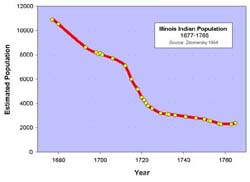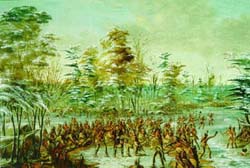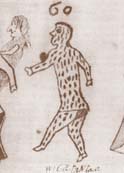
 |
Decline of the Illinois Indian population, 1677-1765. enlarge |
[O]f the once great & powerful nation of Illinois, there remains . . . only about Seventy persons including Men, Women & Children near Kaskaskias, and a few Straggling Peorias about St. Genevieve. (August Chouteau, 1816)![]()
In 1673, the Illinois were a large, powerful group of tribes that numbered more than 10,000 people and occupied a vast territory. However, in 1832, when they ceded the last of their Illinois lands to the United States, they had been reduced, in the State of Illinois, to a single village of fewer than 300 people. The history of the Illinois Indians during the intervening 159 years is a fascinating, but tragic, story of population decline and cultural erosion.
The ultimate cause of the Illinois decline was the colonial expansion of European nations. As France sought to establish a fur-trade empire in Canada, British colonies grew along the Atlantic seaboard and Spain established footholds in Florida and Texas. During the late 1700s, Americans began settling the Ohio River valley and Spain took over the area of Louisiana located west of the Mississippi River. The Illinois got caught in a vise that applied pressure to them from all directions. Warfare and disease caused massive depopulation, while the adoption of European beliefs led to the abandonment of traditional ways of life.
The first of December [1680], we arrived in the evening at the [Kaskaskia] village, where we found nothing but the remains from the fire and the rage of the Iroquois. All was in ruins, and there remained only some ends of burned poles which marked what had been the extent of the village, and on the greater part of which there were fixed the heads of dead persons, eaten by crows. (René-Robert Cavalier, Sieur de La Salle, 1681)![]()
![]()
Henri de Tonty seeking peace with the Iroquois Indians at the Grand Village of the Kaskaskia, 1680. (painting by George Catlin, 1847-48) enlarge
The Illinois had a number of traditional enemies, including Siouan tribes to the northwest, the Osage, Pawnee, and Arikara to the west, and the Quapaw to the south. Beginning in the 1650s, they also came under attack from Iroquois war parties, whose earlier acquisition of firearms gave them a strategic advantage. For example, in 1680 the Iroquois killed or captured more than 700 Tamaroa near the mouth of the Illinois River. The threat of Iroquois raids subsided in the early 1700s, but then hostilities emerged with northern tribes like the Sauk, Fox (Mesquakie), Kickapoo, Dakota (Sioux), and Potawatomi. Pressure also came from southern tribes, including the Quapaw, Shawnee, and Chickasaw. Some conflicts were inspired not by the tribes themselves, but by French, British, and American forces that enlisted Indian warriors as allies.
He [an Illinois Indian named "Henri"] was attacked by smallpox, with all his family: this disease snatched from him at once his wife and some of his children; it rendered the others blind or extremely disfigured. (Gabriel Marest, 1712)![]()
Native drawing of a person suffering from smallpox or measles. (from the Dakota winter count by Yellow Lodge for the year 1845)
![]()
Like many other Native American tribes, the Illinois suffered from deadly European diseases to which they had no immunity. Smallpox epidemics occurred in the region in about 1704, 1732, and 1756. There were also several epidemics of unidentified diseases, one of which killed at least 200 Kaskaskia Indians in 1714.
![]()
|
|
Copyright © 2000 Illinois State Museum

